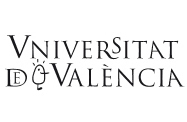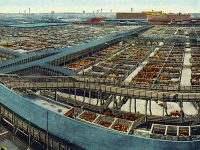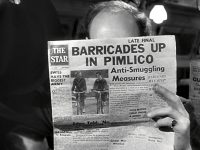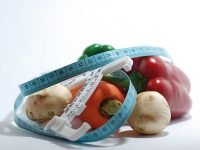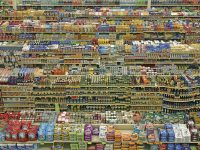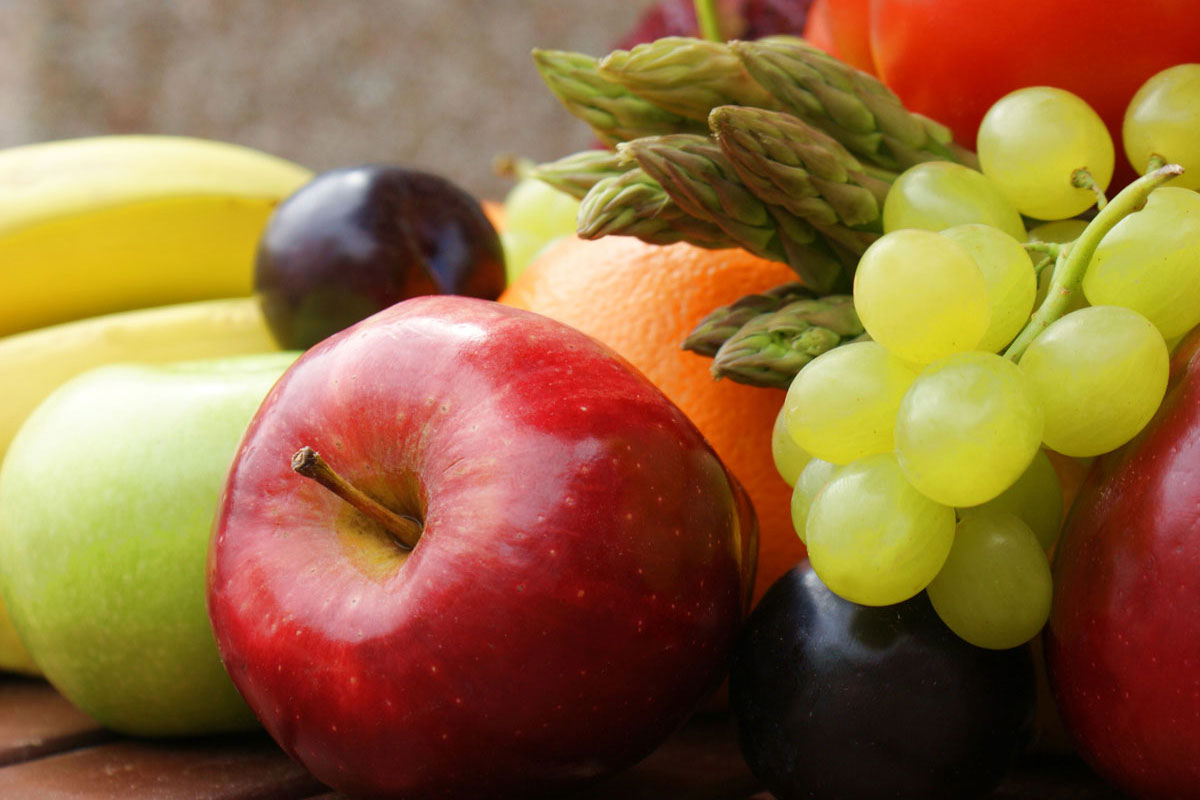
Flavour and texture are two criteria currently used to accept or reject food. Texture is a concept with no clear definition when used in gastronomy. However, materials science can help us to develop objective procedures to measure the texture of foods, for the latter is surely related to its mechanical proprieties.
The texture of food
Flavour and texture are two criteria used to characterise and accept or reject food. The delicate flavour of a Torta del Casar, with its creamy texture, the texture of a juicy sirloin steak or the perfumed taste and grainy texture of a ripe fig have delighted gourmets for years.
The concept of flavour – which summarises a taste and olfactory experience – seems clear, though not everyone agrees with the term used. In English, we will call flavour to the combination of taste and smell.
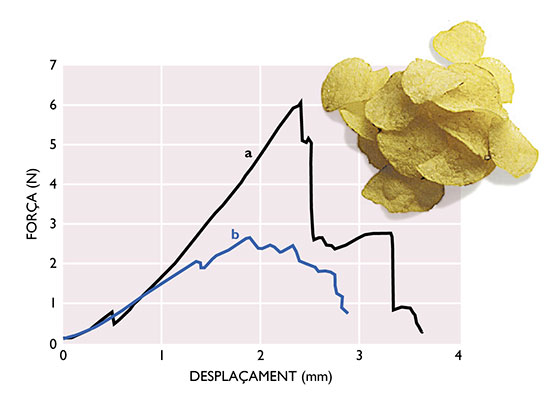
Figure 1. Force-displacement curves corresponding to two types of potato crisps: a) “Gourmet” potato crisps; b) commercial potato crisps. The horizontal axis represents displacement and the vertical axis represents force.
The concept of texture is less clear when used in gastronomy, but it has a precise meaning in other branches of science; in the field of materials it is used to characterise a non-isotropic distribution of crystallographic orientations and it is often said that a texture appears when preferred orientations are detected. In this sense the term is also applied in geology, in the textile industry and in biology. In foods, the word texture is used when we intend to emphasise the sensation caused by its structure or the arrangement of its components, and there have been some attempts to standardise its measurement (ISO 5492).
Measuring the texture of foods is not an easy task. The classic procedure is to invite someone to taste the food in question and ask them to give us their opinion. In this idea, a group of experts is usually trained to review – as objectively as possible and using common terms – the characteristics that hey have detected in the foods. This organoleptic group is intended to represent the typical consumer and to be able to give correct answers. This is clearly a very subjective measurement procedure.
Materials science can help us find objective methods for measuring food texture because their mechanical properties, structure and oral processing are certainly directly related to the texture perceived during ingestion. But we still have a long way to go: the process of chewing and swallowing is complex and has not yet been analysed in sufficient detail to apply the techniques of materials science and, on the other hand, materials experts have paid little attention to foods, which are complex, very hierarchical, anisotropic materials with a rheological behaviour that cannot be ignored.
«Materials science can help us find objective methods for measuring food»
The crunchy sensation – which can be considered a textural characteristic – of some vegetables and fruits depends largely on the arrangement, adhesion and turgidity of cells. The characteristic texture of meat is due to the fibrous structure of muscle tissue and how the fibres are separated when chewed. Mushrooms have been used as a – poor – substitute for meat for more than 2,000 years. Vegetarians have tried to reproduce the fibrous structure – and therefore the texture – of meat using the fungus Fusarium graminearum. Fungal hyphae, though not as rigid and well oriented as muscle fibres, provide a soft and anisotropic material. Perhaps a property of materials such as fracture energy and its different values for the longitudinal and transverse directions to the fibres could give us an idea of the texture of these foods.
In this short communication, we show some attempts – using potato crisps and apples – to measure some aspects of texture based on concepts and techniques of materials science. These are very simplified examples where it is assumed that the material has a very simple behaviour – lineal elastic and brittle – and that it can be characterised by two parameters: the elastic modulus E and the fracture energy R. The progress made in this direction will be very valuable for the growing food industry, which needs to characterise in an objective and reproducible way the textural characteristics of food.
Crunchiness
When we chew food we have a textural experience and, based on it, we usually define foods that fracture delicately and with little effort as crispy. This sensory parameter is called crispness and it is different from crunchiness, which is reserved for food that – though their fracture is fragile – need a bit more effort; this is the case of some fresh vegetables, fruits and many nuts (almonds and especially macadamia nuts). Crispy food is usually cellular – with rigid and fragile walls, – and is obtained from materials such as rice or potatoes. The latter becomes fragile when we fry it properly to remove moisture, giving it a glassy consistency and making it impervious to re-absorbing water.
«When we chew food we have a textural experience and, based on it, we usually define as crispy foods those that fracture delicately and with little effort»
Cellular materials are crispier the larger their cell size and the thicker their walls. We can use potato crisps to illustrate this concept: a panel of experts examined four types of potato crisps, all were fried at 180˚C and were then given a cold wash for one minute. The four types were obtained from various subsequent treatments: a) a hot wash (2 min), b) 2% NaCl wash (2 min); c) 0.5% CaCl2 wash (3 min); d) no further treatment. The expert panel ranked them for crispness and the result was: a, d, c, b. Further analysis of the cellular structure of the crisps confirmed that those whose air-filled cells were numerous and small weren’t as crispy. The same happened regarding the wall thickness of the cells, the crisps with large cells, obtained by fusion of small cells, had thicker walls and were crispier.
The crunchy and firm nature of fruits and vegetables is often associated with cell turgidity, but cell adhesion is also responsible for this appetising property. The exotic Chinese water chestnut – the bulb of an aquatic plant – provides us a good example, as it remains crunchy when cooked. This is due to diferulic acid (a phenolic derivative related to the lignin) which holds the cells together, is hydrophobic and remains covalently attached to the cell membranes and, for this reason, is not dissolved with heat or in the presence of acids (vinegar). The firmness and crunchiness disappear if the adhesion between cells is lost. When this happens in apples, they are said to have a mealy texture. Under these conditions cells can still retain a certain turgidity; if you run your finger over the freshly cut surface of a mealy apple, many cells will adhere to it – giving the sensation of running your finger over a fine sandpaper. These cells are hard and rounded but too small for us to feel when we chew them. That’s why mealy apples seem “dry”.
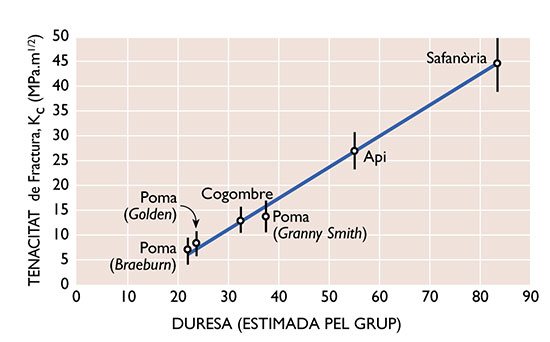
Figure 2. Correlation between texture measurements obtained by organoleptic procedures and using materials science for apples, cucumbers, celery and carrots. The vertical scale shows the measures of KC fracture toughness and the horizontal scale, the mean values of the sensory hardness estimated by an expert panel.
The crunchiness of a particular food is also related to the force exerted by the jaw muscles and in particular, how it varies as the material fractures during mastication. Let’s get back to the potato crisps: figure 1 shows two curves measuring this force and the corresponding relative displacement between the jaws, the upper line (a) corresponds to gourmet crisps, while the bottom one (b) has been obtained from commercial crisps. In both cases, sudden decreases in force as displacement increases are related to the processes of material fracture and to the fracture path. It seems that when many small “steps” occur, the fracture path is more stable and the food seems less crunchy, it being possible to reach the point of having the sensation of chewing a crumbly material. At the other extreme, when the steps are large and few in number, we have the sensation of chewing a hard texture, of crunching the food, as discussed below.
Hard texture
To research the texture of some fruits and vegetables (cucumber, carrot, celery and three apple varieties) a group of 10 female organoleptic panellists aged 33-55 was used. They were selected among people with great sensory acuity and verbal ability to describe the flavours and textures of foods and had received training to learn the techniques used.
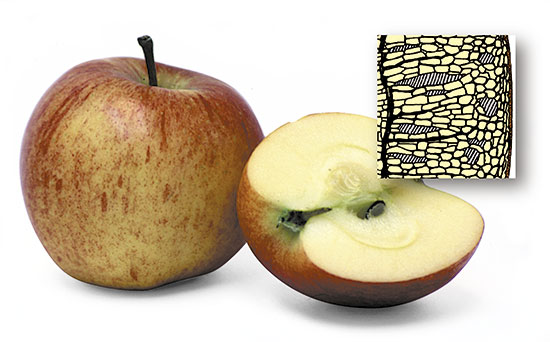
Figure 3. Diagram of the cell structure of an apple, highlighting the orientation of the cells. The shaded regions represent intercellular spaces (Khan, A. A.; Vincent, J. F. V, J. of Materials Science 28, 45, 1993).
Each member of the group tested six products and filled out a questionnaire with 15 questions; the first eight concerned the first bite with the incisors (hardness, crispness, crunchiness, type of breakdown: fast, fragile and noise data: pitch, duration and loudness) and the remaining seven, during chewing with the molars (hardness, crispness or crunchiness, speed of breakdown and the three data about noise). In addition, the Kc fracture toughness of foods was also measured in the laboratory, following the standard process for elastic and brittle materials, using a notched beam in 3-point bending.
The analysis of the results showed a good correlation between fracture toughness and the hardness detected by the organoleptic panel (with a correlation coefficient of 0.992, see Figure 2) and also with crunchiness (correlation coefficient 0.996). This wasn’t the case with the other traits that were measured (the correlation with crispness was 0.448). It seems clear that both the hardness and crunchiness of fruits and vegetables researched are related to the toughness (stress required to start a crack) of food. From the statistical point of view both of these characteristics are identical versus Kc, both the first bite and when using the molars. This is one of the first correlations obtained between a fracture parameter, Kc, and sensory data.
Such correlations may prove very useful to the food industry by reducing the time and cost to characterize textural properties. The above study, with ten people, took 25 days. The time devoted to characterise the hardness and the crunchiness was 25% of the total; about 6 days. By contrast, the fracture tests, 75 in total, lasted for about 10 hours. In other words, using techniques of materials science, the same information was obtained in a fifth of the time. Possibly, the latter information is of higher quality because based on mechanical data, more objective, other properties can be can predicted. In the next section we make several considerations in this direction.
Texture and mechanical tests
Assessments based on the sensation of the texture of food – like crispness, hardness, or crumbliness – are the result of complex processes that involve the gustatory epithelium, tongue, teeth, saliva, auditory signals and food itself undergoing complex deformations, so it is not surprising that attempts to correlate these sensations with simple mechanical tests are often unsatisfactory. The brain effectively integrates all the sensations and gives the perception of crunchiness or granularity. From the point of view of materials science we can only attempt a reductionist approach, trying to imagine the whole process and characterising it using objective parameters; independent of the size, the shape of the food and of the measurement procedure.
This is not always so. One of the most widely used tests in the food industry is the penetrometer test. It involves pressing a sphere, or an indenter, against the material and measuring the force exerted and the mark left. It is apparently a simple, fast, easy and inexpensive test, but there a process of complex and ill-defined deformation hides behind it. Let’s see what happens with apples.
«Food should be an enjoyable experience, and those products that fail to be so have their days numbered, at least in developed countries»
In the apple industry, the texture is measured using a 8mm spherical penetromer and the force exerted and the penetration depth are recorded. Figure 3 shows, in schematic form, the cellular structure of an apple; there is a columnar structure of elongated cells radiating from the centre and which grows spherical closer to the skin. Along with the cells there are air-filled cavities (between 50% and 5% of the volume of the apple, depending on the type and age, young apples have always more air.) When the indenter is applied, the cells next to it are compressed, they slide and some of them break. When the adhesion between the cells is weak, there are more cells to slide past each other than ruptured cells, the indenter penetrates more easily, and we say that they have less texture. This happens with mealy apples, where the adhesion between cells is low and also because they contain more air as cells tend to be rounded. The ease of penetration also depends on the density, the tighter the cells, the most difficult to sink the indenter and, in general, denser apples give the feeling of being more textured, except in some cases. There are a variety of apples, called Spartan, which are early and crunchy but less dense. If the penetrometer is used, they should be classified as mealy apples with little texture, but if a fracture test is performed we can check that they are fragile and, therefore, textured.
Standard mechanical tests intend to measure the forces generated during very simple processes wherein controlled deformation occurs, as in the case of compression, traction or bending. They normally record force according to displacement and, from these data, we obtain stress (force divided by the area of the section that supports it) – strain (displacement divided by the original dimension) curves that are independent of the size and geometry of the material. This is how based on the data from a small steel specimen we can obtain information to calculate the bearing capacity of a bridge or a boat. There is no reason to think that these ideas can’t be used to characterise food, after all, all materials obey the same physical laws.
It is clear that most of these tests have been developed by engineers with structural purposes – having metal and concrete in mind – and that food materials have other purposes. Structural materials are often rigid, linear-elastic, isotropic and little deformable, while biological materials are soft, nonlinear, anisotropic and highly deformable. In general, we do not use food to build houses – except in fairy tales,– but the characterisation, objective and simple, of these tasty materials is a must for the food industry and the challenge future engineers will face.
«Assessments based on the sensation of the texture of food are the result of complex processes that involve the gustatory epithelium, tongue, teeth, saliva, auditory signals and food itself »
Food should be an enjoyable experience, and those products that fail to be so have their days numbered, at least in developed countries. Although price and nutritional advertising are important, in the end flavour and texture are key. As we have already indicated, the sensation of the texture of food is a human experience and to understand it we must rely on several disciplines: physiology, psychology, chemistry, physics… In this short note we have shown how materials science has done its small part. The techniques used in the past had a large subjective component. Thirty years ago, the pressure of the big food companies forced the search for more reliable and objective estimates, but we must not forget that the food business is very old; the tasty texture of figs – as mentioned in the beginning – led ancient Greeks to control their exportation and it also led Roman ships, according to the chronicles, to stop at Menorca to stock up on figs when returning from Hispania to their homeland.
Article based partially in Vincent, J. F. V. “Application of Fracture Mechanics to the Texture of Food”, Anales de Mecánica de la Fractura (M. Elices, M. Fuentes, F. J. Fuenmayor and E. Giner, eds.), vol. 20, pp. 1-7, Benicàssim, April 2003.
